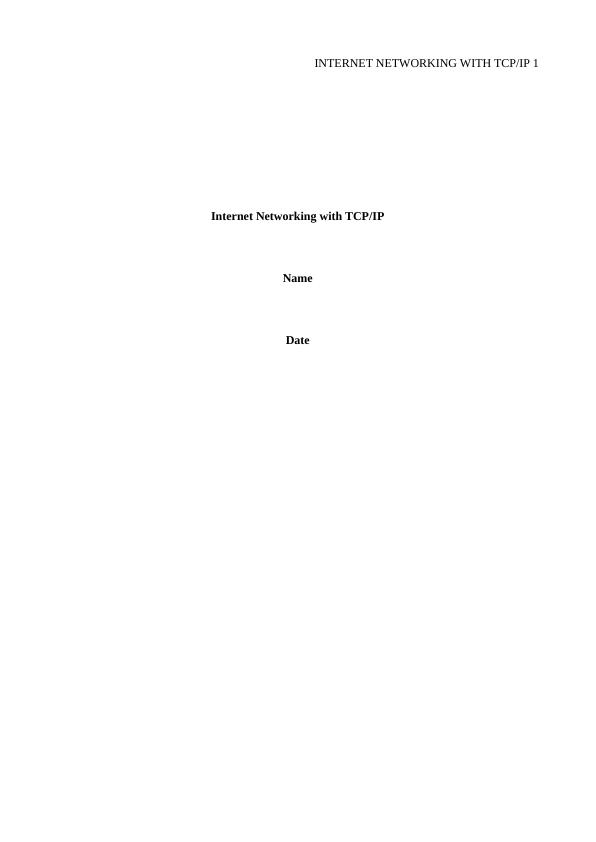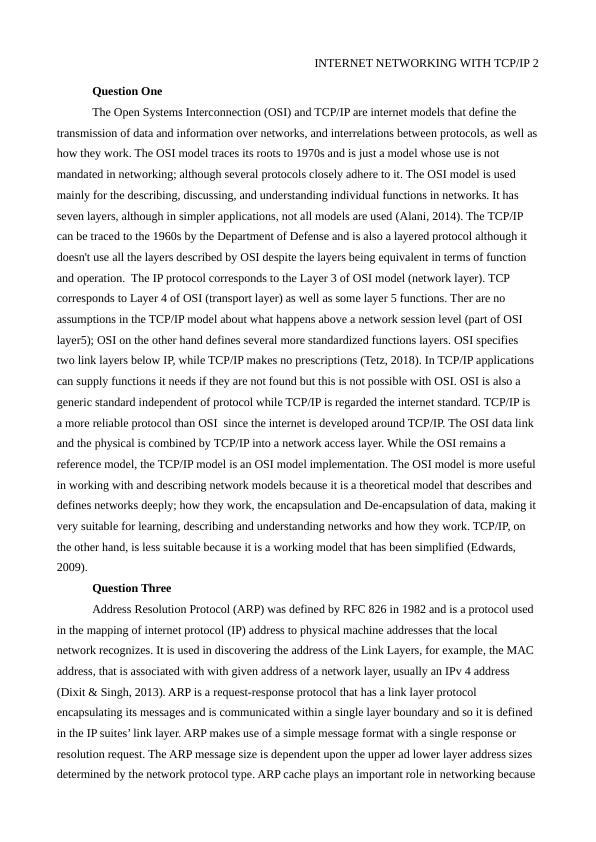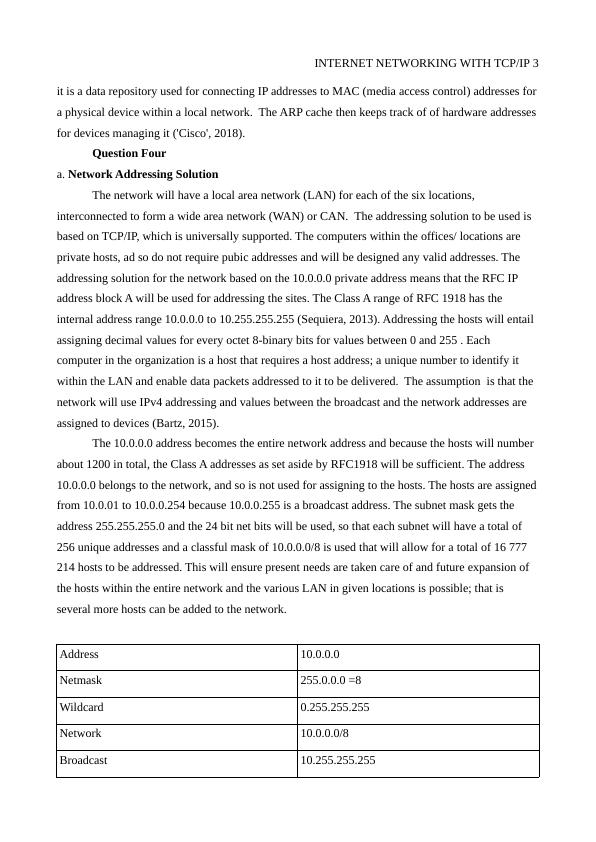Internet Networking with TCP/IP
Added on 2023-06-14
6 Pages1857 Words186 Views
INTERNET NETWORKING WITH TCP/IP 1
Internet Networking with TCP/IP
Name
Date
Internet Networking with TCP/IP
Name
Date

INTERNET NETWORKING WITH TCP/IP 2
Question One
The Open Systems Interconnection (OSI) and TCP/IP are internet models that define the
transmission of data and information over networks, and interrelations between protocols, as well as
how they work. The OSI model traces its roots to 1970s and is just a model whose use is not
mandated in networking; although several protocols closely adhere to it. The OSI model is used
mainly for the describing, discussing, and understanding individual functions in networks. It has
seven layers, although in simpler applications, not all models are used (Alani, 2014). The TCP/IP
can be traced to the 1960s by the Department of Defense and is also a layered protocol although it
doesn't use all the layers described by OSI despite the layers being equivalent in terms of function
and operation. The IP protocol corresponds to the Layer 3 of OSI model (network layer). TCP
corresponds to Layer 4 of OSI (transport layer) as well as some layer 5 functions. Ther are no
assumptions in the TCP/IP model about what happens above a network session level (part of OSI
layer5); OSI on the other hand defines several more standardized functions layers. OSI specifies
two link layers below IP, while TCP/IP makes no prescriptions (Tetz, 2018). In TCP/IP applications
can supply functions it needs if they are not found but this is not possible with OSI. OSI is also a
generic standard independent of protocol while TCP/IP is regarded the internet standard. TCP/IP is
a more reliable protocol than OSI since the internet is developed around TCP/IP. The OSI data link
and the physical is combined by TCP/IP into a network access layer. While the OSI remains a
reference model, the TCP/IP model is an OSI model implementation. The OSI model is more useful
in working with and describing network models because it is a theoretical model that describes and
defines networks deeply; how they work, the encapsulation and De-encapsulation of data, making it
very suitable for learning, describing and understanding networks and how they work. TCP/IP, on
the other hand, is less suitable because it is a working model that has been simplified (Edwards,
2009).
Question Three
Address Resolution Protocol (ARP) was defined by RFC 826 in 1982 and is a protocol used
in the mapping of internet protocol (IP) address to physical machine addresses that the local
network recognizes. It is used in discovering the address of the Link Layers, for example, the MAC
address, that is associated with with given address of a network layer, usually an IPv 4 address
(Dixit & Singh, 2013). ARP is a request-response protocol that has a link layer protocol
encapsulating its messages and is communicated within a single layer boundary and so it is defined
in the IP suites’ link layer. ARP makes use of a simple message format with a single response or
resolution request. The ARP message size is dependent upon the upper ad lower layer address sizes
determined by the network protocol type. ARP cache plays an important role in networking because
Question One
The Open Systems Interconnection (OSI) and TCP/IP are internet models that define the
transmission of data and information over networks, and interrelations between protocols, as well as
how they work. The OSI model traces its roots to 1970s and is just a model whose use is not
mandated in networking; although several protocols closely adhere to it. The OSI model is used
mainly for the describing, discussing, and understanding individual functions in networks. It has
seven layers, although in simpler applications, not all models are used (Alani, 2014). The TCP/IP
can be traced to the 1960s by the Department of Defense and is also a layered protocol although it
doesn't use all the layers described by OSI despite the layers being equivalent in terms of function
and operation. The IP protocol corresponds to the Layer 3 of OSI model (network layer). TCP
corresponds to Layer 4 of OSI (transport layer) as well as some layer 5 functions. Ther are no
assumptions in the TCP/IP model about what happens above a network session level (part of OSI
layer5); OSI on the other hand defines several more standardized functions layers. OSI specifies
two link layers below IP, while TCP/IP makes no prescriptions (Tetz, 2018). In TCP/IP applications
can supply functions it needs if they are not found but this is not possible with OSI. OSI is also a
generic standard independent of protocol while TCP/IP is regarded the internet standard. TCP/IP is
a more reliable protocol than OSI since the internet is developed around TCP/IP. The OSI data link
and the physical is combined by TCP/IP into a network access layer. While the OSI remains a
reference model, the TCP/IP model is an OSI model implementation. The OSI model is more useful
in working with and describing network models because it is a theoretical model that describes and
defines networks deeply; how they work, the encapsulation and De-encapsulation of data, making it
very suitable for learning, describing and understanding networks and how they work. TCP/IP, on
the other hand, is less suitable because it is a working model that has been simplified (Edwards,
2009).
Question Three
Address Resolution Protocol (ARP) was defined by RFC 826 in 1982 and is a protocol used
in the mapping of internet protocol (IP) address to physical machine addresses that the local
network recognizes. It is used in discovering the address of the Link Layers, for example, the MAC
address, that is associated with with given address of a network layer, usually an IPv 4 address
(Dixit & Singh, 2013). ARP is a request-response protocol that has a link layer protocol
encapsulating its messages and is communicated within a single layer boundary and so it is defined
in the IP suites’ link layer. ARP makes use of a simple message format with a single response or
resolution request. The ARP message size is dependent upon the upper ad lower layer address sizes
determined by the network protocol type. ARP cache plays an important role in networking because

INTERNET NETWORKING WITH TCP/IP 3
it is a data repository used for connecting IP addresses to MAC (media access control) addresses for
a physical device within a local network. The ARP cache then keeps track of of hardware addresses
for devices managing it ('Cisco', 2018).
Question Four
a. Network Addressing Solution
The network will have a local area network (LAN) for each of the six locations,
interconnected to form a wide area network (WAN) or CAN. The addressing solution to be used is
based on TCP/IP, which is universally supported. The computers within the offices/ locations are
private hosts, ad so do not require pubic addresses and will be designed any valid addresses. The
addressing solution for the network based on the 10.0.0.0 private address means that the RFC IP
address block A will be used for addressing the sites. The Class A range of RFC 1918 has the
internal address range 10.0.0.0 to 10.255.255.255 (Sequiera, 2013). Addressing the hosts will entail
assigning decimal values for every octet 8-binary bits for values between 0 and 255 . Each
computer in the organization is a host that requires a host address; a unique number to identify it
within the LAN and enable data packets addressed to it to be delivered. The assumption is that the
network will use IPv4 addressing and values between the broadcast and the network addresses are
assigned to devices (Bartz, 2015).
The 10.0.0.0 address becomes the entire network address and because the hosts will number
about 1200 in total, the Class A addresses as set aside by RFC1918 will be sufficient. The address
10.0.0.0 belongs to the network, and so is not used for assigning to the hosts. The hosts are assigned
from 10.0.01 to 10.0.0.254 because 10.0.0.255 is a broadcast address. The subnet mask gets the
address 255.255.255.0 and the 24 bit net bits will be used, so that each subnet will have a total of
256 unique addresses and a classful mask of 10.0.0.0/8 is used that will allow for a total of 16 777
214 hosts to be addressed. This will ensure present needs are taken care of and future expansion of
the hosts within the entire network and the various LAN in given locations is possible; that is
several more hosts can be added to the network.
Address 10.0.0.0
Netmask 255.0.0.0 =8
Wildcard 0.255.255.255
Network 10.0.0.0/8
Broadcast 10.255.255.255
it is a data repository used for connecting IP addresses to MAC (media access control) addresses for
a physical device within a local network. The ARP cache then keeps track of of hardware addresses
for devices managing it ('Cisco', 2018).
Question Four
a. Network Addressing Solution
The network will have a local area network (LAN) for each of the six locations,
interconnected to form a wide area network (WAN) or CAN. The addressing solution to be used is
based on TCP/IP, which is universally supported. The computers within the offices/ locations are
private hosts, ad so do not require pubic addresses and will be designed any valid addresses. The
addressing solution for the network based on the 10.0.0.0 private address means that the RFC IP
address block A will be used for addressing the sites. The Class A range of RFC 1918 has the
internal address range 10.0.0.0 to 10.255.255.255 (Sequiera, 2013). Addressing the hosts will entail
assigning decimal values for every octet 8-binary bits for values between 0 and 255 . Each
computer in the organization is a host that requires a host address; a unique number to identify it
within the LAN and enable data packets addressed to it to be delivered. The assumption is that the
network will use IPv4 addressing and values between the broadcast and the network addresses are
assigned to devices (Bartz, 2015).
The 10.0.0.0 address becomes the entire network address and because the hosts will number
about 1200 in total, the Class A addresses as set aside by RFC1918 will be sufficient. The address
10.0.0.0 belongs to the network, and so is not used for assigning to the hosts. The hosts are assigned
from 10.0.01 to 10.0.0.254 because 10.0.0.255 is a broadcast address. The subnet mask gets the
address 255.255.255.0 and the 24 bit net bits will be used, so that each subnet will have a total of
256 unique addresses and a classful mask of 10.0.0.0/8 is used that will allow for a total of 16 777
214 hosts to be addressed. This will ensure present needs are taken care of and future expansion of
the hosts within the entire network and the various LAN in given locations is possible; that is
several more hosts can be added to the network.
Address 10.0.0.0
Netmask 255.0.0.0 =8
Wildcard 0.255.255.255
Network 10.0.0.0/8
Broadcast 10.255.255.255

End of preview
Want to access all the pages? Upload your documents or become a member.
Related Documents
Internet of Things (IoT) Assignment Samplelg...
|4
|789
|33
Comparison and Contrast of OSI Model with TCP/IP Modellg...
|5
|1249
|450
TCP/IP protocol suite layer and OSI model’s layerlg...
|6
|1480
|60
Layers of OSI model and TCP/IP protocol suitelg...
|7
|1742
|74
Assignment on Internetworking With TCP/IPlg...
|6
|1279
|22
Internetworking with TCP/IP: OSI model, TCP/IP model, ARP, and network designlg...
|13
|1714
|419
